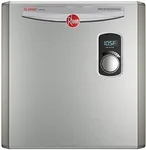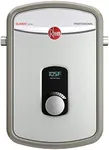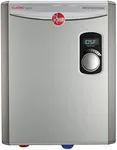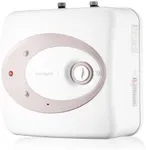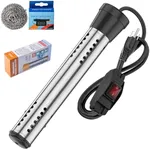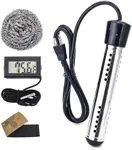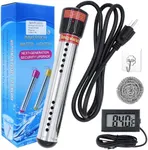Buying Guide for the Best Electric Tankless Water Heaters
When shopping for an electric tankless water heater, it's important to match the appliance to your household's needs since these devices provide hot water on demand and do not store it in a tank. The right model can offer unlimited hot water, save space, and improve energy efficiency, but picking one that's too small can leave you with lukewarm showers and other inconveniences. Before making your choice, consider the water usage patterns in your home and the installation constraints. Understanding the most important specifications will help you decide which heater best fits your household's requirements and ensures you enjoy reliable hot water whenever you need it.Flow Rate (Gallons Per Minute, GPM)Flow rate tells you how much hot water the unit can supply per minute. This is crucial because different activities require different amounts of hot water—for example, a shower uses more than a sink. Flow rates are divided into low (1–2 GPM), medium (2–4 GPM), and high (4+ GPM). Smaller homes or apartments with just one or two points of use at a time can opt for lower flow rates, while larger homes or those needing to run multiple showers and appliances at once should look for higher GPM values. Consider your simultaneous water needs to choose a flow rate that keeps up with your household usage.
Power (Kilowatts, kW)The power rating, measured in kilowatts, determines how quickly the water heater can heat the water as it passes through. Higher power means the unit can handle colder incoming water and higher flow rates. Power is often segmented into low (under 12 kW), medium (12–24 kW), and high (24+ kW). Choose a power rating that matches your desired flow rate and local climate—colder regions need more power to heat up incoming water, while smaller homes in warmer climates may need less.
Temperature RiseTemperature rise is the increase in water temperature the heater can achieve as water passes through. This is important because colder incoming water needs a larger temperature rise to reach comfortable hot water temperatures. Units are designed for certain temperature rises at different flow rates—higher temperature rise at a given flow rate means better performance in cold climates. If you live in a cooler region or expect heavy use, seek out models rated for higher temperature rises at your intended flow rate.
Electrical RequirementsInstallations of these water heaters require certain electrical specifications such as amperage and breaker size. This is important because your home’s existing electrical system must be able to support the heater safely. Requirements range from modest (can run on standard circuits) to heavy-duty (requires new dedicated circuits). Check your current electrical setup and consult with a professional if necessary; pick a model that fits your electrical system or be prepared for possible upgrades.
Size and MountingThese units are generally much smaller than tank heaters, but their physical size and required clearance still matter, especially if you have limited installation space. Sizes are typically compact (easy to fit under sinks), medium (wall-mounted for small spaces), and larger models (need more wall space). Check where you want to install the unit and see what physical size fits best without crowding or causing installation issues.
Control FeaturesModern tankless water heaters often come with features such as digital displays, adjustable temperature settings, and remote controls. These controls make it easier to fine-tune water temperature and monitor performance. Some are simple, with manual dials, while more advanced models offer precise and programmable digital controls. Consider your preference for ease of use—if you want more control over your water temperature and status indicators, choose a model with advanced digital features.

